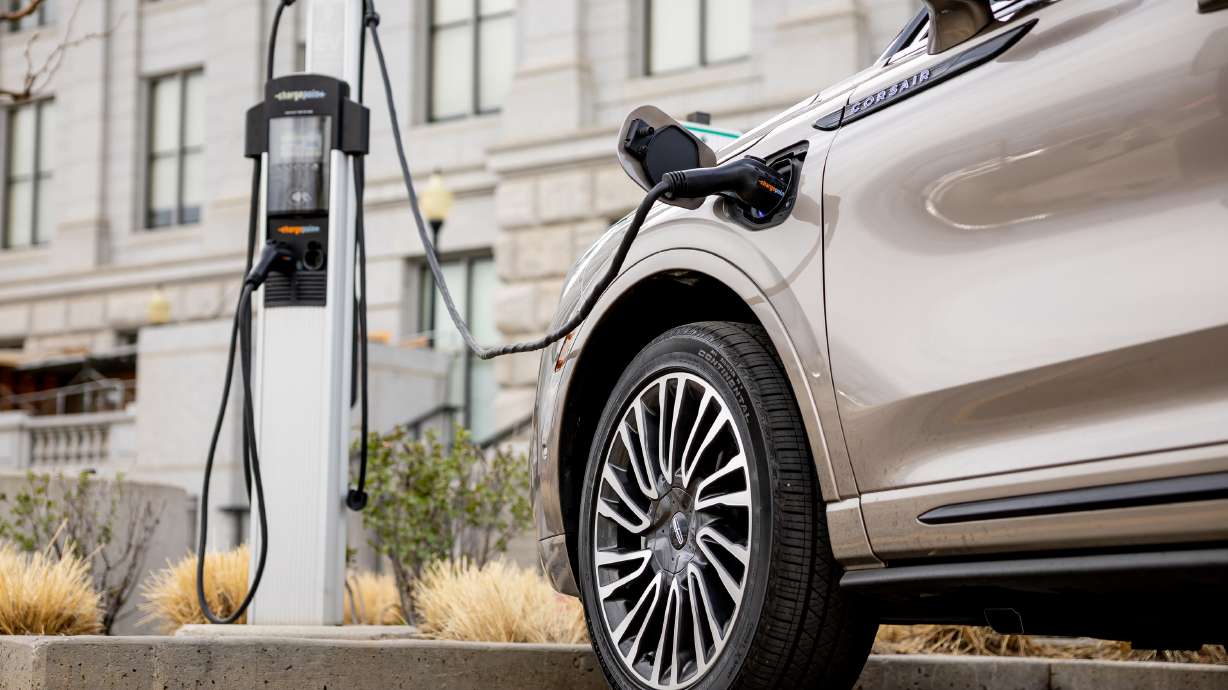Estimated read time: 4-5 minutes
This archived news story is available only for your personal, non-commercial use. Information in the story may be outdated or superseded by additional information. Reading or replaying the story in its archived form does not constitute a republication of the story.
SALT LAKE CITY — Tammie Bostick has seen a lot of change in Utah's approach to mitigating its air pollution problem, especially since she took over as the executive director of Utah Clean Cities.
It started with training drivers to drive the speed limit, keep air in their tires and carpool.
In 2006, the organization's Idle Free program came along, urging drivers to turn their vehicles off if they're not in motion and eventually making it a crime to not do so in Salt Lake City.
Bostick on Tuesday was joined by leaders from various industries and Utah government offices to celebrate the 14th annual Advanced and Alternative Fuels Awareness Month, where she acknowledged the progress being made in the Beehive State.
"Now, we work with 12 different alternative fuels in the (Department of Energy) Clean Cities program. In Utah, we primarily work with compressed natural gas, liquid natural gas, propane, electric and, of course, now hydrogen," Bostick said. "It's really exciting because all of those fuels are available in a renewable form."
She said that for a long time there was a denial about how harmful vehicle emissions are to air quality.
"The changes we see right now in the world's largest transportation system, which is in America, is significant and it's our time," Bostick said. "It's a huge disruption of what's happened before."
Alternative fuel in Salt Lake City and beyond
So, what initiatives to reduce vehicle emissions currently exist throughout Utah?
Bostick said answering that question begins with "integral" private and public partnerships to modernize the transportation sector.
In 2020, Salt Lake City Mayor Erin Mendenhall and the Salt Lake City Council approved a joint resolution to switch most of the city's fleet vehicles to electric over the next six years. Debbie Lyons, director of sustainability for Salt Lake City, said the city last year began working to purchase more plug-in vehicles for its fleet — which already includes 71 electric vehicles — "on an accelerated timeline."
With an uptick in both city and public electric vehicles, the city plans to invest in electric vehicle charging infrastructure throughout the city.
"This year, we're planning to transmit to the city council an updated ordinance that requires all new multi-family construction units to equip at least 20% of their onsite parking to be EV (electric vehicle) ready," Lyons said.
Additionally, most of the city's waste and recycling fleet runs on compressed natural gas, and Lyons said they're looking to follow the lead of ACE Disposal and Recycling's purchase of an electric garbage truck.
Matt Stalsberg, CEO of ACE Disposal and Recycling, said he's constantly asked why "a little garbage company like ACE" decided to buy an electric garbage truck.
"Most importantly, our fuel costs are high, right?" Stalsberg said. "We want to keep the environment clean."
There's the capitalist model that you can drive what you want, but it's the socialist model that we all pay for the consequences of that — which is the poor air quality and the effects it has on our children and on ourselves.
–Tammie Bostick, Utah Clean Cities
ACE was able to purchase the truck through a grant distributed through the Utah Department of Environmental Quality's Clean Diesel Program, said Kim Shelley, executive director of the Utah Department of Environmental Quality.
"This program has distributed over $18 million to fleet owners across the state and was able to provide grants that helped fund both the electric refuse hauler for ACE and electric school buses for Salt Lake (City) School District," Shelley said.
The school district in 2021 received two state grants from the Utah Department of Environmental Quality totaling more than $1.5 million funded by Utah's $35 million share of the Department of Justice's Volkswagen Clean Diesel Settlement.
Ken Martinez, the district's transportation fleet manager, said they currently have eight electric buses on routes every day with four more buses set to be delivered in the coming months.
"Here shortly, we'll have 12% of our fleet (electrified)," Martinez said. "By 2035 — somewhere in there — we're shooting to have 75% of our fleet electric. It's going good."
Related:
Last week, the Biden administration announced the 2022 recipients of the U.S. Environmental Protection Agency's Clean School Bus Program rebate competition, awarding $4.74 million from President Joe Biden's bipartisan infrastructure law to Tintic School District — $790,000 for two buses — and Uintah School District — $3,950,000 for 10 buses.
Martinez said he's planned to meet with Uintah School District's transportation director to help him implement the electric buses into their existing fleet.
So, with so much progress being made, what is Bostick looking toward for the future?
To scale and replicate, she said.
"We need to have our cities take the stance to say, 'If you're going to do work in Salt Lake City, then you're going to be driving a clean vehicle. And if you're going to be delivering, you're going to be delivering in an electric truck. ... Zero emission at the tailpipe,'" Bostick said. "I think our citizens should demand it, and I think we should give our businesses plenty of time to transition and I think we should incentivize it."
"There's the capitalist model that you can drive what you want, but it's the socialist model that we all pay for the consequences of that — which is the poor air quality and the effects it has on our children and on ourselves," she added.











